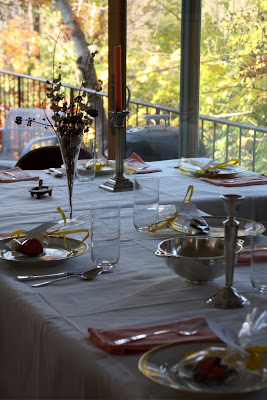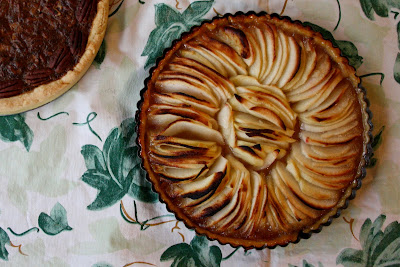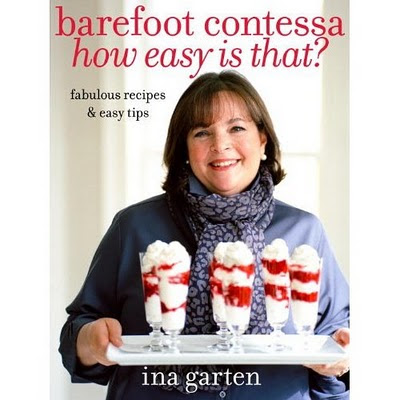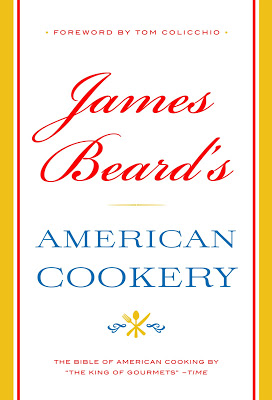
The holiday season, kicked off this past week with Thanksgiving, is as good a time as any to discuss family dinners—the ubiquitous, but often unrecognized tradition that doesn’t exactly necessitate that a big old turkey be placed in the center of the table in order for people to gather around it.
Laurie David’s new cookbook, The Family Dinner: Great Ways to Connect with Your Kids, One Meal at a Time, sheds new light on the importance of family meals—of turning off cell phones, computers, and televisions, slowing down, and feasting on good food and conversation. (If you replace Family Dinner with "Family" Dinner and Your Kids with Your Friends, you'll start to see how this book is as applicable to us quarter-lifers as it is to those cooks with families of their own.)
In addition to a being an environmental advocate, Oscar-winning producer, and full-time mom, Laurie David knows how make her dinner table a place that everyone wants to be, ourselves included. As the second featured interview of our new blog category, Great Minds Eat Alike, Laurie answers some of our questions about how she made family dinner a non-negotiable routine in her household, as well as some lessons that we can take away to share at the table with our friends.
One of the many memorable quotes scattered throughout The Family Dinner comes from Nora Ephron. “A family is a group of people who eat the same thing for dinner,” Laurie quotes her saying. We couldn’t agree more; as 20-somethings, our family is often each other.
We certainly share the philosophy that the most intimate, special moments are those spent enjoying a meal. Perhaps above all other messages in the book, we were thrilled to hear that Laurie, like us, thinks that potlucks are awesome. In her family, nothing gets everyone in a great mood than feeling like they’re contributing. To drive that message home, she asked Phoebe to write a short piece for the sidebar of the book on the 20-something family dinner ritual, where the creation of the meal is shared.
Read on for some of Laurie’s wisdom. For the rest of the tips, including Phoebe's, on how to make your kitchen a greener place, your table full of engaging conversation, and your platters covered with delicious delicious food, we urge you to pick up a copy of The Family Dinner and explore it for yourself.
From our kitchens, albeit small, to yours,
Cara and Phoebe, THE QUARTER-LIFE COOKS
**Interview**
Read on for some of Laurie’s wisdom. For the rest of the tips, including Phoebe's, on how to make your kitchen a greener place, your table full of engaging conversation, and your platters covered with delicious delicious food, we urge you to pick up a copy of The Family Dinner and explore it for yourself.
From our kitchens, albeit small, to yours,
Cara and Phoebe, THE QUARTER-LIFE COOKS
**Interview**
BGSK. In your intro you mention that your family dinners growing up weren’t always the best experiences. What were the failures with those dinners and what have you tried to do differently with your own family?
L.D. The reason that those dinners didn’t work—the food was always good, and we had sit-down dinners Monday through Friday—was the atmosphere at the table. Someone was always getting mad, someone was always getting into a fight or leaving the table crying. As a parent I really didn’t want to repeat that. It made me realize that dinner is more than just about the food-it’s also about the conversation, and I always put a lot of focus on that—there’s a lot of great conversation tips in the book. For some people, figuring out what to talk about is just as hard as figuring out what to cook.
BGSK. Was there an age range for your girls that was particularly hard to tackle family dinners?
L.D. When your kids are really young, you’re really just starting to teach them how to sit at the table, and they have short attention spans. Those early years are challenging, but I think that meal after meal after meal after meal, you realize, they sat for 20, 30 minutes, and everyone gets used to it. Now I can’t get my kids away from the table! Dinner is almost always over, dessert over, conversation continues, and then at some point I say doesn’t anyone have homework? It just shows what happens if you’re consistent. When kids get older they get their own lives, they’re not home as much, swamped with activities and homework, or they don’t really want to be with you, and that’s when a lot of people drop these rituals. But I think this period is when people need rituals the most.
BGSK. Do you always serve dessert?
L.D. Always. It’s one of my rules. Dessert is incredibly important because it gives you a chance, if dinner doesn’t go well or someone gets into a fight, to get back on track. I think also what happens is that if everyone clears the table and helps clean up and then comes back to the table, you’re not eating your main course thinking what you’re doing next. You know you’re there for the duration. I think it slows the dinner down, and I think we all need to slow down.
L.D. The reason that those dinners didn’t work—the food was always good, and we had sit-down dinners Monday through Friday—was the atmosphere at the table. Someone was always getting mad, someone was always getting into a fight or leaving the table crying. As a parent I really didn’t want to repeat that. It made me realize that dinner is more than just about the food-it’s also about the conversation, and I always put a lot of focus on that—there’s a lot of great conversation tips in the book. For some people, figuring out what to talk about is just as hard as figuring out what to cook.
BGSK. Was there an age range for your girls that was particularly hard to tackle family dinners?
L.D. When your kids are really young, you’re really just starting to teach them how to sit at the table, and they have short attention spans. Those early years are challenging, but I think that meal after meal after meal after meal, you realize, they sat for 20, 30 minutes, and everyone gets used to it. Now I can’t get my kids away from the table! Dinner is almost always over, dessert over, conversation continues, and then at some point I say doesn’t anyone have homework? It just shows what happens if you’re consistent. When kids get older they get their own lives, they’re not home as much, swamped with activities and homework, or they don’t really want to be with you, and that’s when a lot of people drop these rituals. But I think this period is when people need rituals the most.
BGSK. Do you always serve dessert?
L.D. Always. It’s one of my rules. Dessert is incredibly important because it gives you a chance, if dinner doesn’t go well or someone gets into a fight, to get back on track. I think also what happens is that if everyone clears the table and helps clean up and then comes back to the table, you’re not eating your main course thinking what you’re doing next. You know you’re there for the duration. I think it slows the dinner down, and I think we all need to slow down.
Dessert can be a cup of tea, or an apple sliced up, or a square of chocolate. It’s not always about homemade cheesecake or apple pie. It’s really about something very simple—the prolonging of the meal.
BGSK. Were there any early pointers that you learned from your mother when it comes to family dinner?
L.D. There’s a little story at the end of the book called "The Hostess with the Mostest". My mother loves to entertain. I have such clear memories of lying on her bed, watching her get dressed for Saturday night, putting the earrings and the makeup on, and I loved the whole process leading up to the time when people actually showed up. Putting the bridge mix into the bowls, the hors d’oeuvres out onto the coffee table, getting the bar ready, and getting dressed—all the things that lead up to entertaining. She definitely passed on the love for the whole entertaining process onto me. It’s one of the reasons I always have so many people at my dinner table, because I just love the celebration of sharing a meal together. I definitely got that from her.
BGSK. For us, the people who are at our table are really more friends than family at the moment. How do your ideas stretch to fit that?
L.D. It’s totally relatable. There’s a great quote from Nora Ephron in the book—your family is whoever you sit down to eat with. If you’re in college, it’s your college friends, if you’re out in the workforce, it’s probably your coworkers and your girlfriends. And if you’re a couple, your family’s each other. In some ways, the tagline of the book should have been “great ways to connect with each other, one meal at a time.”
Family dinners are equally important for people without families nearby--they should have a ritual with their friends. They should be doing potluck meals and doing all the games in this book. They should be having friends invite friends so they’re always widening their circle.
BGSK. Do you have any rituals these days with just your girlfriends?
L.D. I always include a lot of people when I can, and I have a lot of family that lives nearby. There’s rarely a night when my daughter doesn’t say “who’s coming for dinner tonight?” and I love that she’s connecting dinner with both guests and family members. When you’re doing these things with your kids, you’re setting up the ritual for the next generation. When my kids are your age, they’re going to be having friends over and throwing dinner parties.
Cara. You’ll have to get them our book.
BGSK. On the issue of takeout, you have your Sunday night Chinese food tradition…
L.D. I love that I now get Larry to pick up the food. I put the order in, but he’ll go out and pick up the food and bring it home.
Phoebe. So I was going to ask, how do you turn down the allure of getting takeout seven nights a week? But maybe it’s because Larry David can’t pick it up seven nights a week.
L.D. You know what, take-out is fine when you can’t cook. But the truth is, when you’re eating takeout, you don’t know what you are eating. And it’s almost always higher in salt, sugar, and fat. This concept of “convenience”—I put that in quotes—bothers me. It’s not convenient that there are so many people with diabetes in this country. But, on nights when you don’t have time, you can get healthy takeout, have a picnic on the floor, and that will be a memorable dinner.
BGSK. How did the process of becoming an environmental advocate change your family dinners--how did those values get integrated?
L.D. Every single issue I care about crosses the dinner plate, including the issue of global warming. When I was writing the book, there had to be a chapter about how the kitchen is the greenest room in the house. It’s the best place to teach those values.
What you’re buying, how much you’re buying, what you’re wasting—it all has to do with how you’re making dinner. I’m like a composting maniac—I can’t tell you the joy I get from knowing that things are going into my compost instead of into a landfill.
How can we use less plastic? What kinds of pots are we cooking from? How much meat are we eating? Pick your issue. Your personal health and the health of your kids, or the health of the planet. It’s all connected.
Something very simple that we can do tomorrow: start eating less meat. If you eat less of it, you’re going to enjoy it more, and you’ll be able to afford the stuff that’s better. You can buy organic vegetables or grass-fed beef when it’s time to serve meat for dinner.
BGSK. Do you have any tips for composting when you live in a small New York City apartment?
L.D. There are these great small composters—something that sits out on your balcony. It’s just so emotionally rewarding. You’d be surprised how compost doesn’t have a smell to it. It really doesn’t smell. I don’t know why that is.
Phoebe. As part of our new year’s resolutions, we’ll have to figure out how to do it.
L.D. One way is to find a local restaurant that’s doing it or wants to do it, and get involved with that.
BGSK. In keeping food waste to a minimum, do you have any recommendations for making leftovers seem more appealing?
L.D. My first recommendation: let’s come up with a new word for leftovers. It’s such a bad term. I love leftovers! Let’s start a contest to come up with a better word for leftovers.
I have some amazing recipes in the book, where I suggest one or two spices to add to a dish that will change the flavor just enough that you can serve it the next day and people will think you made it from scratch. Good luck finding leftovers in my house—they get devoured the next day.
BGSK. For couples that live together, looking back on your early years of marriage, are there things you would do differently?
L.D. Avoid the pitfalls. For young couples, your family is each other. But it’s become so difficult with computers and the cell phones, for people to connect to with each other. People need to look at meals as the perfect time to do it. We have to recapture this ritual and hold onto it for dear life.
Also, everyone needs a break. Meals are a time to refuel not just your body, but your energy and your spirit. Dinnertime is a gift that the day’s bringing you. If you can’t do dinner, then find another time for this ritual. Have it be breakfast. Or do a before-bed teatime ritual. Or use your weekends—use Sundays to cook together and bond while making food for the week.
The mealtime ritual is about adding joy to your life. This isn’t the idea that dinner is some terrible chore. I love the interview with the Neelys in the book. They talk about how when they’re cooking together, it’s their sexiest time. They pour a glass of wine, light a candle, have fun. This is my idea exactly; to give yourself some really good memorable moments with the person you love.
BGSK. I know a lot of the recipes in the book have ways you can get the kids involved, and we’re always having friends arrive early and ask how to help…do you have any recommendations for good ways to delegate things to adults?
L.D. I think that’s the best thing you can do for your dinner party is to have everyone help. Nothing gets you in a better mood than feeling like you’re contributing. When everyone participates, that’s when you get some ownership over the meal, rather than just serving the food. When my kids contribute and they do two or three things, they basically feel like they’ve made dinner. They come to the table and say, “I made dinner tonight.” If everyone feels they’ve contributed they’re going to enjoy it more. That’s why I love the potluck too. It’s the best way for single people who don’t have a lot of time to get together.
BGSK. Jonathan Safran Foer wrote a beautiful afterword in the book about Thanksgiving. What are your Thanksgiving traditions, and have they changed at all as you’ve honed your methods for family dinners?
L.D. I have the same traditions as everybody else does, but I’ve been thinking a lot about Thanksgiving. You know, Thanksgiving was this tradition that was started to express thanks for the harvest, the seasonal harvest--unbelievable gratitude for what the earth was delivering to the table. We are so far removed from that--the fact that our food is available all year long, we’re not connected any more to how food even grows. We’re hardly growing any of it ourselves. All the ideas of what Thanksgiving is about are being lost. And the idea that we should eat way too much on that day is insane—we eat way too much every day! Again, I think we have to slow down and go back to the original intent of this holiday.
BGSK. What can we put on our table that will help us get there?
L.D. I think that if we think about what is seasonal and local and fresh in your community, that would be a start right there. Maybe don’t have strawberries for dessert. Maybe don’t make a casserole with a vegetable that’s not in season. Really think about what grows in the fall and embrace those foods.
BGSK. Is there anything—even after going through the process of modernizing what we’re eating—that is so memorable from your childhood that you make it for your children now?
L.D. Sweet potatoes with marshmallows on top of it. That is something we have on Thanksgiving, and they associate Thanksgiving with it. As Alice Waters says, “food is love memories.” So I guess I’ll keep serving those sweet potatoes.
BGSK. Were there any early pointers that you learned from your mother when it comes to family dinner?
L.D. There’s a little story at the end of the book called "The Hostess with the Mostest". My mother loves to entertain. I have such clear memories of lying on her bed, watching her get dressed for Saturday night, putting the earrings and the makeup on, and I loved the whole process leading up to the time when people actually showed up. Putting the bridge mix into the bowls, the hors d’oeuvres out onto the coffee table, getting the bar ready, and getting dressed—all the things that lead up to entertaining. She definitely passed on the love for the whole entertaining process onto me. It’s one of the reasons I always have so many people at my dinner table, because I just love the celebration of sharing a meal together. I definitely got that from her.
BGSK. For us, the people who are at our table are really more friends than family at the moment. How do your ideas stretch to fit that?
L.D. It’s totally relatable. There’s a great quote from Nora Ephron in the book—your family is whoever you sit down to eat with. If you’re in college, it’s your college friends, if you’re out in the workforce, it’s probably your coworkers and your girlfriends. And if you’re a couple, your family’s each other. In some ways, the tagline of the book should have been “great ways to connect with each other, one meal at a time.”
Family dinners are equally important for people without families nearby--they should have a ritual with their friends. They should be doing potluck meals and doing all the games in this book. They should be having friends invite friends so they’re always widening their circle.
BGSK. Do you have any rituals these days with just your girlfriends?
L.D. I always include a lot of people when I can, and I have a lot of family that lives nearby. There’s rarely a night when my daughter doesn’t say “who’s coming for dinner tonight?” and I love that she’s connecting dinner with both guests and family members. When you’re doing these things with your kids, you’re setting up the ritual for the next generation. When my kids are your age, they’re going to be having friends over and throwing dinner parties.
Cara. You’ll have to get them our book.
BGSK. On the issue of takeout, you have your Sunday night Chinese food tradition…
L.D. I love that I now get Larry to pick up the food. I put the order in, but he’ll go out and pick up the food and bring it home.
Phoebe. So I was going to ask, how do you turn down the allure of getting takeout seven nights a week? But maybe it’s because Larry David can’t pick it up seven nights a week.
L.D. You know what, take-out is fine when you can’t cook. But the truth is, when you’re eating takeout, you don’t know what you are eating. And it’s almost always higher in salt, sugar, and fat. This concept of “convenience”—I put that in quotes—bothers me. It’s not convenient that there are so many people with diabetes in this country. But, on nights when you don’t have time, you can get healthy takeout, have a picnic on the floor, and that will be a memorable dinner.
BGSK. How did the process of becoming an environmental advocate change your family dinners--how did those values get integrated?
L.D. Every single issue I care about crosses the dinner plate, including the issue of global warming. When I was writing the book, there had to be a chapter about how the kitchen is the greenest room in the house. It’s the best place to teach those values.
What you’re buying, how much you’re buying, what you’re wasting—it all has to do with how you’re making dinner. I’m like a composting maniac—I can’t tell you the joy I get from knowing that things are going into my compost instead of into a landfill.
How can we use less plastic? What kinds of pots are we cooking from? How much meat are we eating? Pick your issue. Your personal health and the health of your kids, or the health of the planet. It’s all connected.
Something very simple that we can do tomorrow: start eating less meat. If you eat less of it, you’re going to enjoy it more, and you’ll be able to afford the stuff that’s better. You can buy organic vegetables or grass-fed beef when it’s time to serve meat for dinner.
BGSK. Do you have any tips for composting when you live in a small New York City apartment?
L.D. There are these great small composters—something that sits out on your balcony. It’s just so emotionally rewarding. You’d be surprised how compost doesn’t have a smell to it. It really doesn’t smell. I don’t know why that is.
Phoebe. As part of our new year’s resolutions, we’ll have to figure out how to do it.
L.D. One way is to find a local restaurant that’s doing it or wants to do it, and get involved with that.
BGSK. In keeping food waste to a minimum, do you have any recommendations for making leftovers seem more appealing?
L.D. My first recommendation: let’s come up with a new word for leftovers. It’s such a bad term. I love leftovers! Let’s start a contest to come up with a better word for leftovers.
I have some amazing recipes in the book, where I suggest one or two spices to add to a dish that will change the flavor just enough that you can serve it the next day and people will think you made it from scratch. Good luck finding leftovers in my house—they get devoured the next day.
BGSK. For couples that live together, looking back on your early years of marriage, are there things you would do differently?
L.D. Avoid the pitfalls. For young couples, your family is each other. But it’s become so difficult with computers and the cell phones, for people to connect to with each other. People need to look at meals as the perfect time to do it. We have to recapture this ritual and hold onto it for dear life.
Also, everyone needs a break. Meals are a time to refuel not just your body, but your energy and your spirit. Dinnertime is a gift that the day’s bringing you. If you can’t do dinner, then find another time for this ritual. Have it be breakfast. Or do a before-bed teatime ritual. Or use your weekends—use Sundays to cook together and bond while making food for the week.
The mealtime ritual is about adding joy to your life. This isn’t the idea that dinner is some terrible chore. I love the interview with the Neelys in the book. They talk about how when they’re cooking together, it’s their sexiest time. They pour a glass of wine, light a candle, have fun. This is my idea exactly; to give yourself some really good memorable moments with the person you love.
BGSK. I know a lot of the recipes in the book have ways you can get the kids involved, and we’re always having friends arrive early and ask how to help…do you have any recommendations for good ways to delegate things to adults?
L.D. I think that’s the best thing you can do for your dinner party is to have everyone help. Nothing gets you in a better mood than feeling like you’re contributing. When everyone participates, that’s when you get some ownership over the meal, rather than just serving the food. When my kids contribute and they do two or three things, they basically feel like they’ve made dinner. They come to the table and say, “I made dinner tonight.” If everyone feels they’ve contributed they’re going to enjoy it more. That’s why I love the potluck too. It’s the best way for single people who don’t have a lot of time to get together.
BGSK. Jonathan Safran Foer wrote a beautiful afterword in the book about Thanksgiving. What are your Thanksgiving traditions, and have they changed at all as you’ve honed your methods for family dinners?
L.D. I have the same traditions as everybody else does, but I’ve been thinking a lot about Thanksgiving. You know, Thanksgiving was this tradition that was started to express thanks for the harvest, the seasonal harvest--unbelievable gratitude for what the earth was delivering to the table. We are so far removed from that--the fact that our food is available all year long, we’re not connected any more to how food even grows. We’re hardly growing any of it ourselves. All the ideas of what Thanksgiving is about are being lost. And the idea that we should eat way too much on that day is insane—we eat way too much every day! Again, I think we have to slow down and go back to the original intent of this holiday.
BGSK. What can we put on our table that will help us get there?
L.D. I think that if we think about what is seasonal and local and fresh in your community, that would be a start right there. Maybe don’t have strawberries for dessert. Maybe don’t make a casserole with a vegetable that’s not in season. Really think about what grows in the fall and embrace those foods.
BGSK. Is there anything—even after going through the process of modernizing what we’re eating—that is so memorable from your childhood that you make it for your children now?
L.D. Sweet potatoes with marshmallows on top of it. That is something we have on Thanksgiving, and they associate Thanksgiving with it. As Alice Waters says, “food is love memories.” So I guess I’ll keep serving those sweet potatoes.
Read more...










.jpg)






